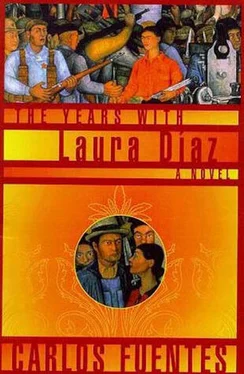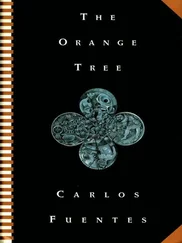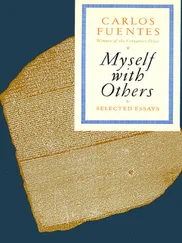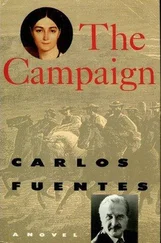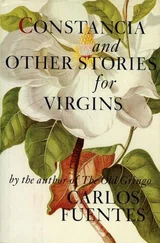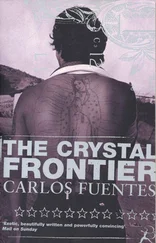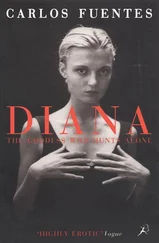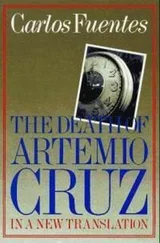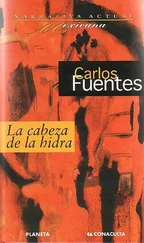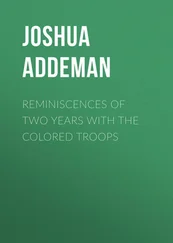On the back of the canvas, Santiago had written: “Art isn’t modern. Art is eternal. Egon Schiele.”
Line dominated color. Which is why the colors were so strong. The black ship. The red half of the Creator. The greenish red of the apple peel that was the mutable skin of the serpent. But Eve’s skin was as translucent as that of a Memling Virgin, while Adam’s was spotty, green, yellow, and sick, like an adolescent painted by Schiele.
The man stared at the woman. The woman stared at the sky. But neither of them was falling. Because both desired each other. There was that equivalence in the difference which Laura made her own, comparing her own emotions to those of her son, the young, dead artist.
She hung Santiago the Younger’s painting in her living room and understood for all time that the son was father of the mother, that, unwittingly, Laura Díaz the photographer owed more to her own son than to any other artist. At first she did not understand this, and the secret, unknown identification was for that reason all the stronger.
Now nothing mattered but the equivalence of the emotion.
Show after show of photographs followed, sales first to newspapers and magazines and then in books.
Blessings of animals and birds.
Old men with huge mustaches gathered around singing corridos from the Revolution.
Flower vendors.
The crowded pools on St. John’s Day.
The life of a metalworker.
The life of a hospital nurse.
Her celebrated photograph of a dead gypsy woman with no lines on her hand, open under her breasts, a gypsy with an erased destiny.
And now something she owed Jorge Maura: a report on the exiled Spanish Republicans in Mexico.
Laura now realized that for years the Spanish Civil War had been the epicenter of her historical life, not the Mexican Revolution, which had passed through the state of Veracruz so mildly and tangentially, as if dying in the Gulf were a unique, moving, and untouchable privilege reserved for Laura’s older brother, Santiago Díaz, sole protagonist, as far as she was concerned, of the 1910 insurrection.
In Spain, on the other hand, Jorge Maura, Basilio Baltazar, and Domingo Vidal had fought, the young gringo, Jim, had died, and the sad gringo, Harry, had survived. In Spain, the beautiful and young Pilar Méndez was shot at the Roman gate of Santa Fe de Palencia by order of her own father, the Communist mayor Alvaro Méndez.
Bearing that heavy emotional weight, Laura began to photograph the faces of Spanish exile in Mexico. President Cárdenas had given sanctuary to a quarter million Republicans. Each time she photographed one of them, Laura remembered with emotion Jorge’s trip to Havana to rescue Raquel from the Prinz Eugen , anchored opposite Morro Castle.
Each one of her models could have suffered that fate: jail, torture, execution. She understood that.
She photographed the miracles of survival. She knew that’s who they were.
The philosopher José Gaos, disciple of Husserl like Jorge Maura and Raquel Mendes-Alemán, leaning on the iron railing above the patio of the Escuela de Mascarones, the philosopher with a patrician Roman head, bald and strong, as strong as his jaw, as strong as his pencil-thin lips, as skeptical as his myopic eyes behind their small, round glasses, suitable for a Franz Schubert of philosophy. Gaos leaning on the railing, and from the beautiful colonial patio the young men and women of the School of Philosophy raise their faces to look at the master with smiles of admiration and gratitude.
Luis Buñuel arranged to meet her in the bar of the Parador, where the director ordered perfect martinis from his favorite bartender, Córdoba, while he replayed the film of a cultural cycle through his memory, which went from the Student Residence in Madrid to the filming of Un Chien Andalou, in which Buñuel and Dali used the eye of a dead fish surrounded by eyelashes to simulate the heroine’s eye sliced open with a straight razor, to L’Age d’Or and its image of the ecclesiastical hierarchy transformed into petrified bone on the coast of Mallorca, to his participation in Parisian Surrealism in its New York exile, to Dalí’s denunciation (“Buñuel is a Communist, an atheist, a blasphemer, and an anarchist. How can you let him work in the Museum of Modern Art?”), to his arrival in Mexico with forty dollars in his pocket.
Humor, anger, and daydreams passed ceaselessly and simultaneously across Buñuel’s green eyes: his gaze stopped on a fixed point in his past, and Laura photographed a boy in the Aragonese village of Calanda playing drums on Good Friday until his hands bled, this to free himself from the sensual charm of the image of the Virgin of Pilar, inhabitant of his onanistic childhood bed.
Thanks to the intervention of the Basque writer Carlos Blanco Aguinaga, Laura photographed the marvelous poet from Málaga, Emilo Prados, in his modest apartment on Lerma Street. She’d met him before with Jorge Maura. Prados was hidden in a couple of rooms behind mountains of books and papers, sickness and exile etched in every line on his face, but able to transform suffering into two expressions Laura was able to photograph. The infinite sweetness of his face was that of an unredeemed Andalusian saint now veiled by a cascade of white locks and thick, aquarium-style glasses, as if the poet, embarrassed by his own innocence, wanted to conceal it. And you could see the lyric strength behind his suffering, poverty, disillusion, old age, and exile:
If I could give you
all the light of dawn …
Like the sun, I would
slowly pierce your breast,
until I emerged without blood
or pain into the night …
Manuel Pedroso, the wise old Andalusian who had been rector of the University of Seville, was adored by the small group of his young disciples who every day went with him as he walked from the Law School near the Zócalo to his small apartment on Amazonas Street. Laura left graphic testimony of that daily journey, as well as of gatherings in the master’s library, packed with ancient books that smelled of tropical tobacco. Francisco Franco’s troops had burned his library in Seville, but Pedroso recovered jewel after jewel in the secondhand bookstalls in La Lagunilla, Mexico City’s thieves’ market.
The books were stolen from him, other thieves stole from other people, but the books always returned, like nostalgic and unremitting lovers, to Pedroso’s long, thin hands, a gentleman painted by El Greco, hands always on the verge of tensing, warning, as if convoking a ceremony of thought. Laura captured Pedroso in the instant when he held out his hands with their long, beautiful fingers to beg for some light from the world, to bank the fires of intolerance, and to affirm his faith in his Mexican students.
Laura photographed a noisy, cheery, argumentative, and affectionate group of young exiles who adapted to Mexico but who never abandoned Spain, who always spoke with the Castilian lisp and let their eyes express the tenderness they felt for everything they had explicitly renounced: chocolate with the parish priest, the novels of Pérez Galdós, café discussion groups, old women in black, tasty treats like hot churros, cante hondo , and bullfights, the punctuality of church bells and funerals, the madness of families who took to their beds to avoid forever the temptations of the world, the flesh, and the devil. Laura photographed them in their perpetual, eternal arguments, as if they were Irishmen and didn’t know each other because they came from Madrid, Navarra, Galicia, and Barcelona and because their names were Oteyza, Serra Puig, Munoz de Baena, García Ascot, Xirau, Durán, Segovia, and Blanco Aguinaga.
Читать дальше
